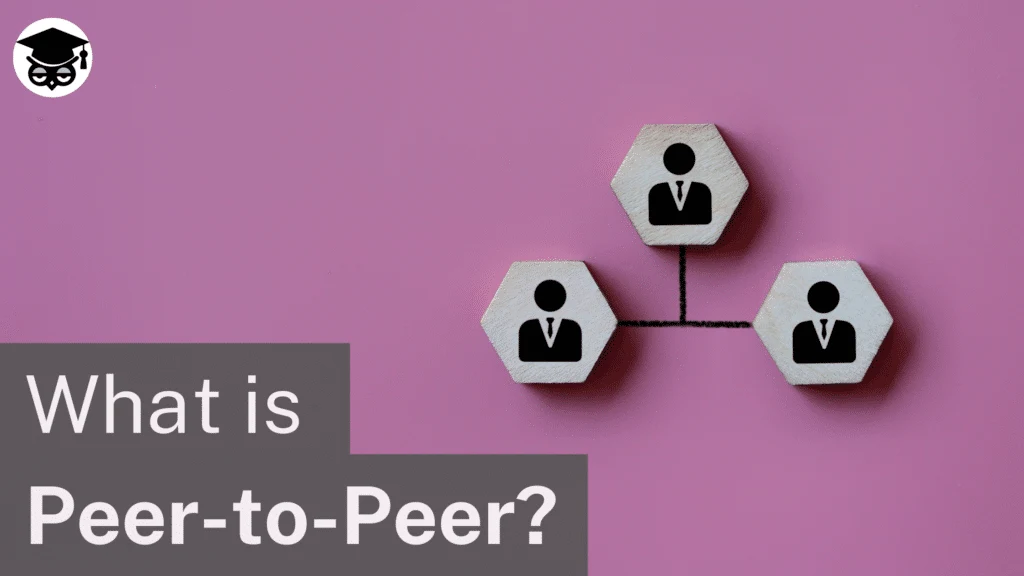What is Peer to Peer (P2P)?
Peer-to-peer (P2P) refers to a system/interaction where participants deal directly with one another. There is no third-party intermediary.
The Long Definition
The term peer-to-peer describes systems or interactions that don’t have a centralized intermediary connecting the parties. Instead, participants deal directly with one another.
A P2P system has a network architecture that links participants to one another rather than through a common central server or intermediary. This allows network participants to interact directly with each other (a P2P interaction). For instance, they can transfer files, send messages, and even transact money without going through a third party.
It is assumed that each participant has equal status. They are all peers, hence the term peer-to-peer.

History of Peer-to-Peer Networks
Any instance where two computers communicate with each other without going through a centralized server is peer-to-peer. This concept is as old as computer networking.
The earliest form of a P2P network is ARPANET. Created in 1969, it’s considered to be the precursor to the internet. The network was mainly used for academic and research purposes, where it allowed multiple computers to communicate directly with each other.
In the 1980s, personal computers became popular in homes and businesses. And with them, businesses started using P2P networks for file sharing. They did this by creating local area networks (LANs) using ethernet cables.
Up until this point, P2P networks were physical. They relied on hardware, like cables to connect participants. But things would change completely in the 90s.
The emergence of the Internet and the World Wide Web led to the development of more sophisticated P2P networks. By the end of the decade, millions of people were using the internet.
This culminated in the creation of Napster in 1999. Napster was the first popular P2P application. Unlike the early P2P network, Napster was not entirely dependent on a physical network. It was a virtual network that allowed users to share music files through the internet.
P2P more P2P file-sharing applications have been created. These include popular torrenting clients like BitTorrent, uTorrent, and qBitTorrent. The use of P2P networks has also extended beyond file sharing. Today, they’re also used for distributed computing and cryptocurrency transactions. These uses will be explained in more detail later.

How Do Peer-to-Peer Networks Work?
Traditional computer networks use client-server architecture. There is a central server, with which the participants (clients) communicate. Let’s say you want an image from your favorite artist.
In the client-server model, the artist uploads their work to a centralized server. It is stored there. To get it, you communicate with the server by requesting a download. If the server accepts, then you can download it. The central server, in this case, acts as an intermediary between you and the creator.
P2P networks, on the other hand, link participants directly with one another. So, rather than go through a server, users can communicate with each other. In the above example, a P2P network will allow the creator to share their image directly with you. And once you receive it, you can also share it with other users in the network.
To be part of a P2P network, one must run the relevant client software. This software allows the participant to become both a client and a server. They’re both the user and provider of resources. Basically, a participant can receive data from other participants and be a source of data for the other participants.
This is best illustrated in P2P file-sharing programs. When you use an app like BitTorrent to download a file, you receive the files in bits from other devices in the network. You’re the client. At the same time, the files downloaded on your device are made available for download by other devices that call for it. You’re the server.
Other types of P2P networks function similarly. What differs is the resource that is being shared. For example, in a blockchain, participants share the record of crypto transactions. They regularly check against each other’s copies to ensure that the ledger is accurate and up to date.

Pros and Cons of Peer-to-Peer Networks
P2P networks have several advantages over traditional client-server models:
Distributed architecture
Traditional models rely on the centralized server to work. The server is the heart of the system. This creates a single point of failure. If the server fails, the network collapses.
On the other hand, a P2P network consists of nodes spread out across different locations. This creates a distributed architecture. Furthermore, these nodes have equal status. The network is not dependent on any particular node to work.
This distribution eliminates a single point of failure. If one computer fails or gets hacked, the network will still work just fine.
No central authority
P2P networks are decentralized by nature. No single participant has control over the system. Instead, the nodes collaborate and contribute equally to the network. This lack of centralized control protects users from censorship.
Cost-effective
P2P requires participants to use their own hardware. Take file sharing for instance. Rather than storing files in a central server, the files are stored in the user’s laptops and computers. This makes the whole system cost-effective because it eliminates the costs that come with running and maintaining a central server.

But like with everything else, there are some disadvantages. These include:
Complexity
It requires a significantly higher level of technical expertise to set up a P2P network than a client-server one. Furthermore, for businesses, managing such a network can be challenging. As for the users, there is a steep learning curve. You need to be pretty tech-savvy to make the most out of a P2P network.
Legal Issues
P2P networks are not illegal. However, they’re associated with several legal issues. The biggest of these is copyright infringement. Some users use P2P networks to share unlicensed copies of copyrighted files, like games, music, movies, etc.
Applications of Peer-to-Peer Technology
P2P networks have many applications in the modern world. These include;
- File sharing: File sharing is the oldest application of P2P networks. Using software like BitTorrent, people share large files quickly without using a centralized server.
- Computing: P2P networks are used for distributed computing. This is a type of computing where heavy computational tasks are distributed across multiple computers. Participants essentially contribute their processing powers to help complete such tasks.
Distributed computing is popular in scientific studies.
- Blockchain: Blockchains are arguably the most revolutionary P2P networks so far. Blockchain technology allows users to send and receive funds (in form of cryptocurrencies and tokens) across the globe without using an intermediary. That way, they have allowed for faster and cheaper transactions.
